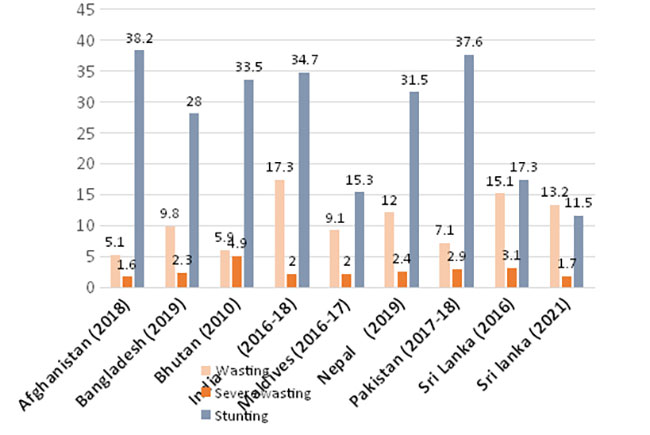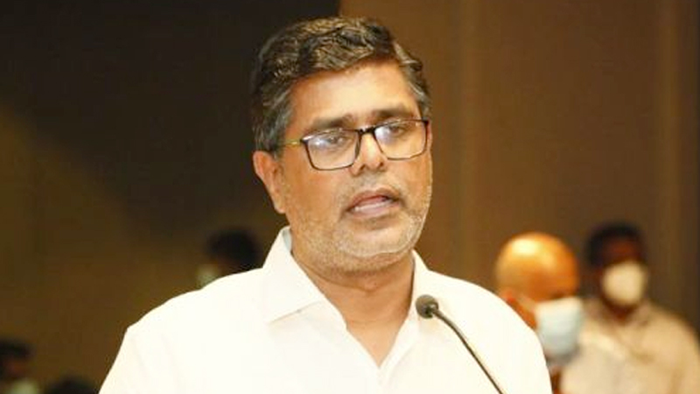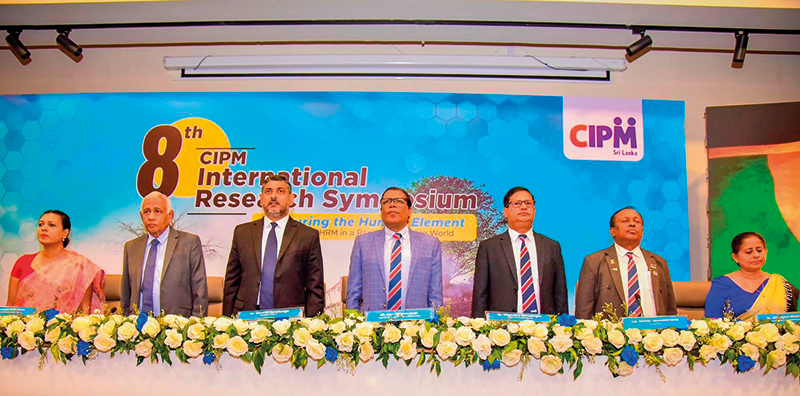News
Malnutrition to rise due to increased poverty and high food prices

Malnutrition will rise in the face of increased poverty and high food prices, the Sri Lanka Medical Nutrition Association, Nutrition Society of Sri Lanka, Dieticians’ Association and the Scaling Up Nutrition (SUN) People’s Forum say.
Therefore, they urge the authorities to stabilise the gains achieved in nutrition status of the vulnerable in Sri Lanka, especially of children less than 5 years of age.
The associations say that there are three measurements of malnutrition that the world uses to compare the nutrition status of a country and the various regions. These measurements are assessed among children less than 5 years as all children grow in the same pattern and speed (trend) at this age as genetic differences do not come into play. Children under 5 therefore are considered as the sentinel or observation group of the whole of the population nutrition status. Any change in the diet is quickly reflected among children especially of this age. The measurements are weight-for-age, weight-for-height (thinness – wasting) and height-for-age (shortness – stunting)
Sri Lanka is currently the country with the least stunted children under 5 years in the South Asian Region with a prevalence of 11.5% (Stunting denotes low height for age as a result of chronic malnutrition). This situation was seen just before the current economic crisis.
Many of the South Asian countries have a stunting prevalence of over 30%. It is important to compare the prevalence of nutrition status among countries, at the same time, in order to have a level playing field.
Over the past 30 years,stunting or shortness, also known as chronic or long term malnutrition measured as height-for-age has continued to reduce, thus seeing a marked improvement among children in this age group. This improvement is due to the fact that the other form of childhood malnutrition, which is wasting or thinness, also known as acute or short term malnutrition which is measured by weight-for-height, has been arrested, before it converts into stunting or loss of height.
This positive trend in reducing chronic malnutrition can be attributed to the following:
1) Successive governments, whatever their ills, have been committed to supporting public health programs that have arrested wasting at the right time before it converts to stunting
2) The status of food and nutrition security not being compromised to an extent that is detrimental to nutrition status of the most vulnerable such as under 5s. This positive situation has been brought about by supplementary and therapeutic feeding for children under 5, micronutrient supplementation for pregnant and lactating mothers and children of this age group and beyond, growth monitoring and promotion meticulously done, food assistance programs and agricultural assistance to farmers to name a few of the interventions.
However, it is expected that malnutrition will rise in the face of increased poverty and high food prices brought about by the current crisis. Currently the levels of poverty have risen bringing it to 14% from a previous value of 6.7%. (Humanitarian Needs and Priorities Plan – UN Joint Assessment Sri Lanka, June to Sept 2022).This amounts to 700,000 families out of approximately 4.9 million, which are “nutritionally at risk”.
There should be a systematic program of intervention especially targeting these households and their vulnerable family members without piecemeal approaches on the part of the state and non-state actors.
The Sri Lanka Medical Nutrition Association, the Nutrition Society of Sri Lanka, the Dieticians Association and the Scaling Up Nutrition (SUN) People’s Forum strongly urges all entities working on food and nutrition in Sri Lanka to act fast and in a coordinated approach to arrest the deterioration of these families.
Development organizations and the media are strongly urged to use accurate data and provide a balanced picture, when giving media exposure to the malnutrition status of Sri Lankans especially children. It is important to cite accurate current figures obtained from reputed organizations when communicating with the media.

The following interventions are recommended by the above associations:
1. Immediate supply of therapeutic food to the ≈27,000 children under 5 years who are severely malnourished.
2. Support by way of supplementary feeding for the ≈207,000 moderately malnourished children under 5 years.
3. Accelerate the existing mechanism to early identification and correction of growth faltering of children under five years to prevent acute malnutrition.
3. Household food and agriculture support should be provided to families of children who have begun to falter in their growth in order to prevent them reducing into the pile of the undernourished. Supplementary food is also important for these children. These growth faltering children amount to approximately 500,000, as seen through regular growth monitoring reports. It is also important to identify these children on time, before they start on a downward curve.
4. Support the popularizing of healthy and creative menus which include mixed curries and dishes, one dish meals and healthy snacks which are less cost intensive and easy to prepare.
5. Open “Sahana Salas” or shops which sell cheaper food of good value which will be accessible to all income groups.
The above-mentioned associations all have as our objective good nutrition and health of our citizens and we are available to collaborate with partners who come forward.
News
US sports envoys to Lanka to champion youth development

The U.S. Embassy in Colombo welcomed the U.S. Sports Envoys to Sri Lanka, former National Basketball Association (NBA) and Women’s National Basketball Association (WNBA) players Stephen Howard and Astou Ndiaye, from June 8 through 14.
The Public Diplomacy section of the U.S. Embassy said that it would launch a weeklong basketball program intended to harness the unifying power of sports, made possible through collaboration with Foundation of Goodness and IImpact Hoop Lab.
While in Sri Lanka, Howard and Ndiaye, both retired professional basketball players, will conduct a weeklong program, Hoops for Hope: Bridging Borders through Basketball. The Sports Envoys will lead basketball clinics and exhibition matches and engage in leadership sessions in Colombo and Southern Province for youth aged 14-18 from Northern, Uva, Eastern and Western Provinces, offering skills and leadership training both on and off the court. The U.S. Envoys will also share their expertise with the Sri Lanka Basketball Federation, national coaches, and players, furthering the development of basketball in the country. Beyond the clinics, they will collaborate with Sri Lankan schoolchildren to take part in a community service project in the Colombo area.
“We are so proud to welcome Stephen and Astou as our Sports Envoys to Sri Lanka, to build on the strong people-to-people connections between the United States and Sri Lanka,” said U.S. Ambassador Julie Chung. “The lessons that will be shared by our Sports Envoys – communication, teamwork, resilience, inclusion, and conflict resolution – are essential for leadership development, community building, equality, and peace. The U.S. Sports Envoy program is a testament to our belief that sports can be a powerful tool in promoting peace and unity.”
News
Rahuman questions sudden cancellation of leave of CEB employees

SJB Colombo District MP Mujibur Rahuman in parliament demanded to know from the government the reasons for CEB suspending the leave of all its employees until further notice from Thursday.
MP Rahuman said that the CEB has got an acting General Manager anew and the latter yesterday morning issued a circular suspending leave of all CEB employees with immediate effect until further notice.
“We demand that Minister Kanchana Wijesekera should explain this to the House. This circular was issued while this debate on the new Electricity Amendment Bill was pending. There are many who oppose this Bill. The Minister must tell parliament the reason for the urge to cancel the leave of CEB employees,” the MP said.However, Speaker Mahinda Yapa Abeywardena prevented Minister Wijesekera responding to the query and said that the matter raised by MP Rahuman was not relevant.
News
CIPM successfully concludes 8th Annual Symposium

The Chartered Institute of Personnel Management (CIPM) successfully concluded the 8th Annual CIPM Symposium, which took place on 31st May 2024. Themed “Nurturing the Human Element—Redefining HRM in a Rapidly Changing World,” the symposium underscored the pivotal role of human resource management (HRM) in today’s dynamic global landscape. Since its inception in 1959, CIPM has been dedicated to advancing the HR profession through education, professional development, and advocacy, solidifying its position as Sri Lanka’s leading professional body for HRM.
Ken Vijayakumar, the President of the CIPM, graced the occasion as the chief guest. The symposium commenced with the welcome address by the Chairperson, Prof. Arosha Adikaram, followed by the Web Launch of the Symposium Proceedings and Abstract Book by the CIPM President. The event featured distinguished addresses, including a speech by Chief Guest Ken Vijayakumar, President of CIPM, and an address by Guest of Honor Shakthi Ranatunga, Chief Operating Officer of MAS Holdings Pvt. Ltd., Sri Lanka.
The symposium also featured an inspiring keynote address by Prof. Mario Fernando, Professor of Management and Director of the Centre for Cross Cultural Management (CCCM) at the University of Wollongong, Australia.
Vote of Thanks of the inauguration session was delivered by Dr. Dillanjani Weeratunga, Symposium Co-chair.
The symposium served as a comprehensive platform for researchers to present their findings across a wide range of critical topics in HRM. These included Cultural Diversity and Inclusion, Talent Development and Retention, Ethical Leadership and Corporate Social Responsibility, Adapting to Technological Advancements, Mental Health and Well-being at Work, Global Workforce Challenges, Employee Empowerment, and Reskilling and Upskilling.
The plenary session was led by Prof. Wasantha Rajapakse. Certificates were awarded to the best paper presenters during the valedictory session, followed by a vote of thanks delivered by Kamani Perera, Manager of Research and Development.
The annual symposium of CIPM was a truly inclusive event, attracting a diverse audience that spanned undergraduates, graduates, working professionals, research scholars and lecturers. This widespread interest highlights the symposium’s significance in the field of HRM, offering a unique opportunity for everyone to network and learn from scholarly brains.The CIPM International Research Symposium was sponsored by Hambantota International Port, Sri Lanka Institute of Information Technology (SLIIT), E B Creasy & Co. PLC, and Print Xcel Company.












